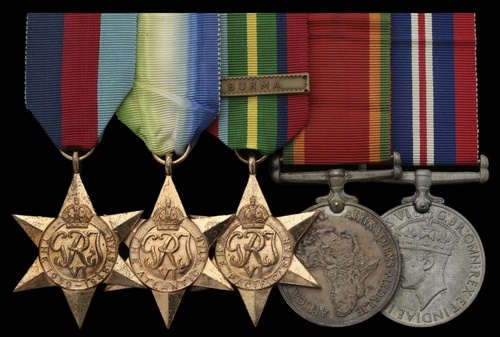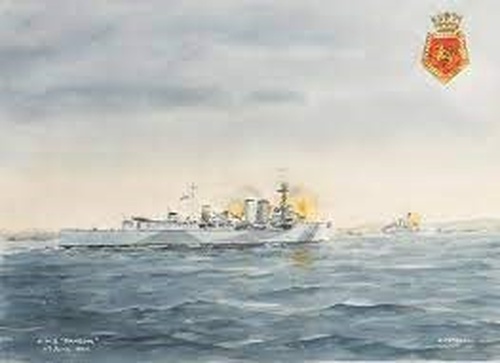Auction: 22003 - Orders, Decorations and Medals
Lot: 396
'Jahore was already abandoned except for a rear-guard dismantling the guns, blowing up workshops and destroying machinery. Air raids were constant. Bombs landed in the water alongside, in the jetty alongside but never on Dragon and a feeling began to grow amongst her crew that they were going to survive this war. The naval rear-guard handed over to the 93rd Argyll and Sutherland Highlanders and the ships left, leaving Dragon and Scout as guard-ships. Eventually it was time for them, too, to leave and, with lots of cries of "good luck", the naval base was left to its army defenders.
Under continued bombing attack the two ships moved down to Singapore and started taking aboard women and children. Singapore harbour started emptying out as the last merchantmen laden with refugees started their runs for safety. Eventually at about twelve noon Dragon cast off, took station next to the Canadian Pacific liner Empress of Asia, and then, with other stragglers fought their way through to Batavia, also under air attack. Dragon was the last warship out of Singapore before it surrendered … '
'In the Wake of H.M.S. Dragon', an article by Captain Ivor C. Little, South African Navy, refers.
A Second World War campaign group of five awarded to Leading Stoker E. W. Pearson, South African Naval Force (V.)
Drafted to the cruiser H.M.S. Dragon at the beginning of the war, he saw considerable action in the Far East and was lucky indeed to escape the grasp of the Japanese at the Battle of the Java Sea
1939-45 Star; Atlantic Star; Pacific Star, clasp, Burma; War Medal 1939-45; Africa Service Medal 1939-45, all officially named '68489 E. W. Pearson', with Union Defence Force enclosure and Record Office letters, in named envelope of issue addressed to 'Mr. E .W. Pearson, Dunedin, Chudleigh Road, Plumstead, Cape Town', good very fine, the Pacific Star with Burma clasp rare to a South African recipient (5)
Eric Walter Pearson was born in the Cape Province, South Africa on 5 November 1923 and joined the South African Division of the Royal Naval Volunteer Reserve (S.A.N.F. (V.)) as a Stoker 2nd Class in December 1940, aged 17 years.
Quickly drafted to the ship's company of the cruiser H.M.S. Dragon, he remained similarly employed until she was handed over to the Polish Navy in January 1943. In consequence, he witnessed considerable action in the Far East, where Dragon was engaged at the evacuation of troops from various locations, including Singapore, and often in the face of sustained Japanese aircraft attacks.
That story is admirably related 'In the Wake of H.M.S. Dragon', by Captain Ivor C. Little, South African Navy. He takes up the story following Dragon's part at the evacuation of Singapore:
'Singapore had fallen, Sumatra was going, and the next job was to evacuate Batavia. Tanjong Priok was under heavy attack when Dragon steamed in from Sumatra to take charge of the evacuation convoy in company with Scout. Everything that could float moved out, through the Sunda Straits and into the Indian Ocean and safety. Despite heavy machine-gunning and bombing this makeshift convoy reached safety unscathed. Dragon and Scout then headed back to Batavia for the final evacuation. In the meantime, the rest of the fleet was taking a pasting at the hands of the Japanese at the Battle of Bali, a battle now all but forgotten. The consequences were, however, that the Japanese had got ashore at Bali, held most of Malaya, Sumatra, Borneo, Bali, the Celebes, and were going after Batavia and Java.
The remnants of the fleet gathered at Tanjong Priok and endured one air attack after the other. During this time a strange happening occurred, once again in the world of rugby. H.M.S. Exeter had a rugby team that hadn't been defeated in 14 games and who were mostly Welsh. Dragon had an undefeated team which included 13 South Africans. That evening in a lull between air raids the two teams took the field for a magnificent match which ended in a 0-0 draw. South African Eric Little was the referee and for this received his Royal Navy rugby "blue" or "colours" … '
Battle of the Java Sea
Captain Little continues:
'Rear-Admiral Karel Doorman's objective with this fleet, known as the ABDA fleet, was to attack a large convoy approaching from Java. On 27 February 1942 he found the convoy and immediately attacked. The Japanese escorting fleet was roughly equal to the ABDA fleet and consisted of two heavy cruisers, two light cruisers and fourteen destroyers. The Japanese however had air superiority, the ships were in good repair and the men fresh. Doorman's crews by contrast were tired and nervous and his ships badly in need of overhaul. The battle, later to be known as the Battle of the Java Sea, began with a salvo of 8-inch shells fired from one of the Japanese cruisers at extreme range. Houston and Exeter answered. The range closed rapidly and although the ABDA fleet drew first blood, about an hour after the action began H.M.S. Exeter was hit by an 8-inch shell that penetrated to one of her boiler rooms and severed a main steam line without exploding. With her speed suddenly cut to seven knots she turned away from the enemy, creating considerable confusion in the ABDA battle line. The Japanese then launched a torpedo attack and one of the torpedoes broke a Dutch destroyer in half. The ABDA fleet immediately retaliated with a torpedo attack of their own which damaged two Japanese destroyers but resulted in the loss of one Allied destroyer. When night fell the Japanese fell back on to their convoy pursued by Doorman minus Exeter which was limping back to Soerabaja. He was spotted and illuminated by Japanese aircraft and shortly after midnight Java was torpedoed by a Japanese cruiser. Whilst swinging away De Ruyter was also torpedoed. The two Dutch ships went down with the loss of 344 men. Houston and Perth escaped into the darkness and headed for the Sunda Strait.
The following night, short of ammunition and badly in need of repairs, they came across the main Japanese invasion fleet. In the action that followed they accounted for four transports before the Perth was stopped by a torpedo and then sunk by gunfire. The Japanese then turned their attention to the Houston which went down firing. Of her crew of 1064 officers and men only 368 survived and her Captain, Albert H. Rooks, was posthumously awarded the Congressional Medal of Honour. Exeter, escorted by H.M.S. Encounter and U.S.S. Pope had fought her way through to Soerabaja, carried out repairs and also sailed for the Sunda Strait, separating Sumatra from Java and the only way of escape into the Indian Ocean. There the three ships were caught on a beautiful flat, calm sunny morning by four Japanese eight-inch cruisers. The three smaller ABDA ships fought their way forward but by noon were sunk and their survivors taken into captivity. Dragon thus missed by a few miles and hours the total destruction of the ABDA fleet in the Java Sea Battle. The entire fleet of 13 ships was lost, Java invaded and the Japanese gained undisputed naval supremacy in the South-West Pacific.
Daring evacuation from Padang and beyond
Little continues:
'The five ships of Dragon's section represented the last Allied Naval presence in the Far East and decided to run for safety after performing one last job. Zig-zagging through the islands off the West Coast of Sumatra and keeping close inshore in a tremendous tropical storm the ships escaped undetected into the Sunda Straits. There they entered the harbour of Padang in Sumatra, which was already in Japanese hands. In their haste to occupy Sumatra however, the Japanese did not have enough troops to garrison the place effectively. In this case the nearest garrison to Padang was in a town lying in a hollow a few miles away from the harbour. Entering the harbour at midnight the three cruisers lay off whilst the two destroyers went alongside and by 3 a.m. had evacuated over a thousand civilians and Indian soldiers. One destroyer even had the audacity to refuel whilst lying alongside. The whole evacuation took place without a shot being fired and by dawn the whole force was on its way to Colombo.
After two days Dragon transferred her passengers to Hobart and then retraced her steps alone back to the Sunda Straits to pick up the liner Kedah which had broken down whilst laden with refugees. Dragon found her, took her in tow and brought her in to Colombo without incident. There the Dragon went into dry-dock whilst her crew were sent up into the mountains for seven days to a place called Dyalatalawa. By Easter Sunday 1942 Dragon was back in commission when Colombo was raided by 75 Japanese aircraft in a full-scale air raid on the docks. The Japanese Navy was operating in the Bay of Bengal and they were now after the shipping in Colombo. Admiral Layton thus decided to search for and destroy the Japanese first. The Dragon steamed hundreds of miles on the fringe of the fleet during this operation, but to their horror found nothing except British survivors. What had happened was that the main fleet had in fact found the Japanese, or rather the Japanese Air force had found them. Sustained Japanese air attacks had accounted for the Cornwall, Dorsetshire, Hermes, Vampire and Hollyhock. Amongst their crews were many dead and missing South Africans.
Dragon however returned unscathed to Colombo. There seven young South Africans were called aft and told that they had been selected for a commission. Five were drafted to the Straits Steamer Kelatan and the remainder were put aboard the Laconia. The stories of the latter group would be an article in itself. Kelatan did a commercial voyage in convoy via Seychelles and Mombasa to Durban but Laconia was torpedoed N.E. of Ascension Island whilst laden with Italian prisoners and the two South Africans aboard found themselves prisoners in their turn of the Vichy French until released by the Americans.
Dragon was then, whilst in Colombo, re-assigned to a new Eastern Fleet and was with this fleet when it entered Mombasa at the same time as the humble Kelatan. She was still the Navy's Champion rugby ship and whilst in Mombasa she defeated the garrison team 3-0. The next day she sailed in company with the fleet to attack Diego Suarez in Madagascar. By now she was getting tired, as was her crew, and she then returned home for a long refit in Chatham in time for Xmas 1942.'
Subsequent career
Pearson, who was advanced to Leading Stoker in January 1943, afterwards held appointments at the drafting establishment Assegai, in addition to serving in the submarine depot ship Lucia in the period January 1943 to July 1945.
He was discharged in South Africa in October 1945.
Subject to 20% VAT on Buyer’s Premium. For more information please view Terms and Conditions for Buyers.
Sold for
£700
Starting price
£160







